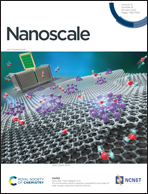Tuning of electron transport layers using MXene/metal–oxide nanocomposites for perovskite solar cells and X-ray detectors†
Abstract
This work elaborates on the decoration of metal oxides (ZnO and Fe3O4) between MXene sheets for use as the supporting geometry of PCBM electron transport layers (ETLs) in perovskite solar cells and X-ray detectors. The metal oxide supports for carrying the plentiful charge carriers and the hydrophobic nature of MXenes provide an easy charge transfer path through their flakes and a smooth surface for the ETL. The developed interface engineering based on the MXene/ZnO and MXene/Fe3O4 hybrid ETL results in improved power conversion efficiencies (PCEs) of 13.31% and 13.79%, respectively. The observed PCE is improved to 25.80% and 30.34% by blending the MXene/ZnO and MXene/Fe3O4 nanoparticles with the PCBM layer, respectively. Various factors, such as surface modification, swift interfacial interaction, roughness decrement, and charge transport improvement, are strongly influenced to improve the device performance. Moreover, X-ray detectors with the MXene/Fe3O4-modulated PCBM ETL achieve a CCD-DCD, sensitivity, mobility, and trap density of 15.46 μA cm−2, 4.63 mA per Gy per cm2, 5.21 × 10−4 cm2 V−1 s−1, and 1.47 × 1015 cm2 V−1 s−1, respectively. Metal oxide-decorated MXene sheets incorporating the PCBM ETL are a significant route for improving the photoactive species generation, long-term stability, and high mobility of perovskite-based devices.

- This article is part of the themed collection: Halide Perovskite Optoelectronics


 Please wait while we load your content...
Please wait while we load your content...